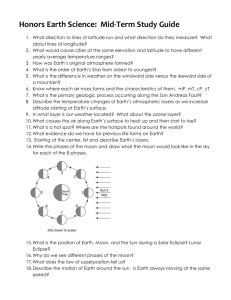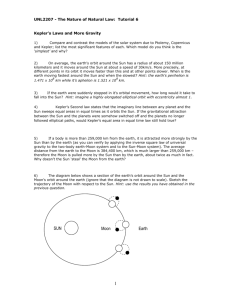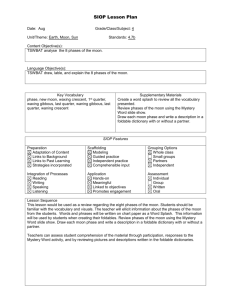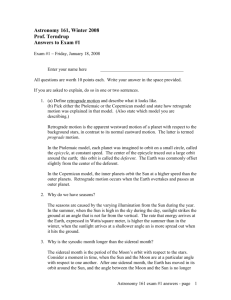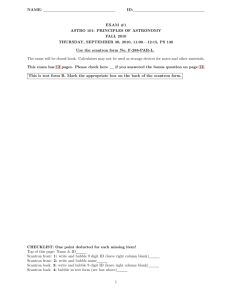Astronomy 100: Introduction to Astronomy: Exam #1 Solutions
advertisement
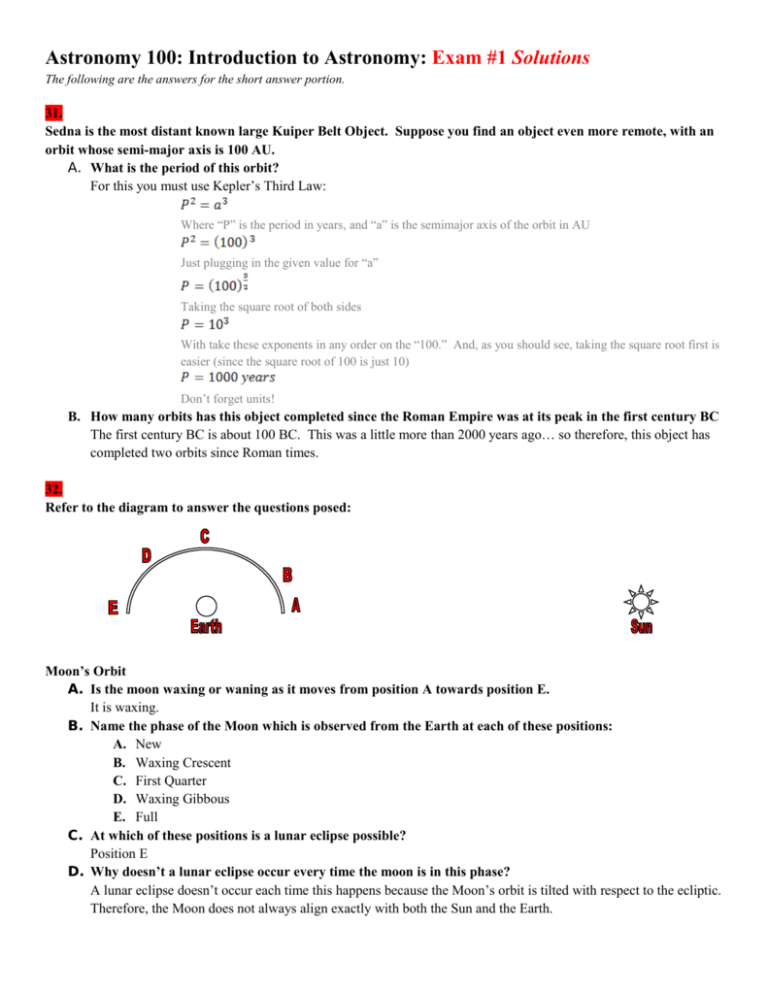
Astronomy 100: Introduction to Astronomy: Exam #1 Solutions The following are the answers for the short answer portion. 31. Sedna is the most distant known large Kuiper Belt Object. Suppose you find an object even more remote, with an orbit whose semi-major axis is 100 AU. A. What is the period of this orbit? For this you must use Kepler’s Third Law: Where “P” is the period in years, and “a” is the semimajor axis of the orbit in AU Just plugging in the given value for “a” Taking the square root of both sides With take these exponents in any order on the “100.” And, as you should see, taking the square root first is easier (since the square root of 100 is just 10) Don’t forget units! B. How many orbits has this object completed since the Roman Empire was at its peak in the first century BC The first century BC is about 100 BC. This was a little more than 2000 years ago… so therefore, this object has completed two orbits since Roman times. 32. Refer to the diagram to answer the questions posed: Moon’s Orbit A. Is the moon waxing or waning as it moves from position A towards position E. It is waxing. B. Name the phase of the Moon which is observed from the Earth at each of these positions: A. New B. Waxing Crescent C. First Quarter D. Waxing Gibbous E. Full C. At which of these positions is a lunar eclipse possible? Position E D. Why doesn’t a lunar eclipse occur every time the moon is in this phase? A lunar eclipse doesn’t occur each time this happens because the Moon’s orbit is tilted with respect to the ecliptic. Therefore, the Moon does not always align exactly with both the Sun and the Earth. 33. Kinetic Energy = ½ mV2 Gravitational Potential Energy = mgh The acceleration due to gravity on the Earth is 10 m/s/s A. Using the information given, compute the speed with which you will hit the ground if you jump from a second story window that is 5 m high This is a conservation of energy problem, and the whole jist with conservation of energy problems is that the initial energy equals the final energy. Kinetic and Gravitational Potential Energy form the two components of the total energy… Kinetic and Potential are the two components of the total energy Here we’re just putting in the given equations The initial velocity and the final height are both zero – and this cancels out their respective terms The masses cancel out This is just rearranging the equation to isolate the final velocity (which is what we’re interested in). Now we can start plugging things in 10 m/s You should make sure that you follow the units – and end with something of the units of velocity. B. The moon Miranda has only 1% of the surface gravity of the Earth. From how high would you have to start to reach the ground at the same speed you found in (a)? Taking the equation from above, we found: We can rearrange this to get it in terms of Now we can plug in the value of g given. Make sure you get units of height! 34. Draw a sketch illustrating what is expected for the phases of Venus in both the geocentric (Ptolemaic) and Heliocentric (Copernican) cosmologies. Explain why the two are different and describe how this difference provides a test to distinguish between them. Who was the first to perform this test and what result was found? HELIOCENTRIC (Copernican) GEOCENTRIC (Ptolemaic) (the planets all orbit the sun) (the planets, and sun, all orbit the Earth) In the geocentric model, Venus is always between the Earth and the sun (orbiting on an epicycle). This means that we would never see any phase larger than a crescent phase. For the heliocentric model, Venus orbits the sun, just like Earth – so we would expect to see a full range of phases (from full through new, and back again) Therefore, observing whether you see just crescent phases or all the phases can become a test for each model. Galileo was the first to perform this test, and he observed a full range of phases – thus falsifying the geocentric model, and proving the heliocentric one. 35. (extra credit) Is the moon closer to being new or full today? The moon was closer to being full on October 16th (just had to look at the sky once and a while to know this!)


